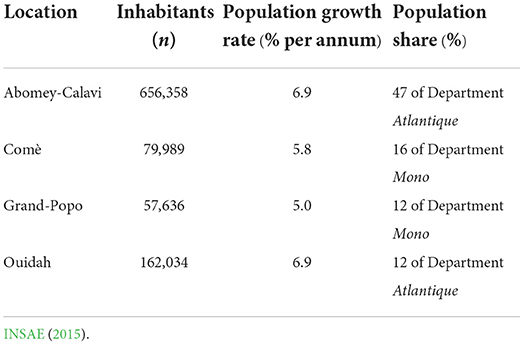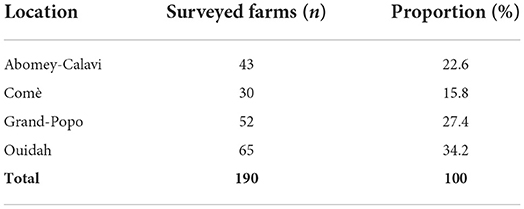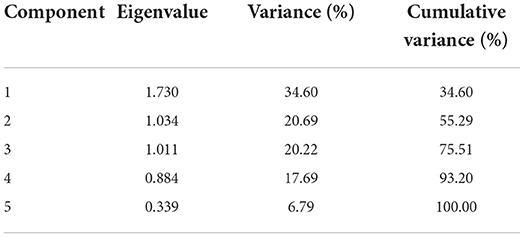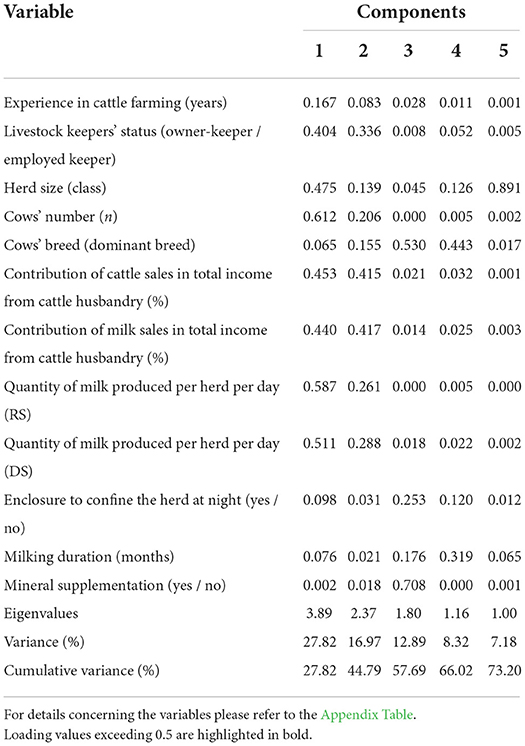- 1Ecole des Sciences et Techniques de Production Animale, Faculté des Sciences Agronomiques, Université d'Abomey-Calavi, Abomey-Calavi, Benin
- 2Animal Husbandry in the Tropics and Subtropics, University of Kassel / Georg-August-Universität Göttingen, Göttingen, Germany
- 3Ecole d'Economie, Socio-Anthropologie et Communication pour le Développement Rural, Faculté des Sciences Agronomiques, Université d'Abomey-Calavi, Abomey-Calavi, Benin
In sub-Saharan Africa, rapid population growth, urbanization, increasing incomes, and changing dietary preferences are the main drivers of the rising demand for livestock products, especially fresh milk and derived products. To meet this demand, there is an increasing number of dairy cattle farms in the densely populated coastal zone of Benin, where the country's largest city and commercial capital Cotonou is located. To identify and characterize the peri-urban dairy production systems in this region, 190 cattle keepers were surveyed, using the snowball sampling method, in four municipalities neighboring Cotonou. Information on their socio-economic characteristics, cattle herd sizes, and herd management practices were collected through questionnaire-based face-to-face interviews. Factor analysis of mixed data followed by hierarchical clustering on principal components, implemented in R statistical software, were applied to classify the surveyed farms into homogeneous groups. Results revealed six types of peri-urban dairy cattle farms differing mainly in their cows' breeds, herd sizes, and daily amount of milk produced. Most herds (88%) were owned by urban dwellers, mainly civil servants and traders, who entrusted the management of their cattle to hired professional herders. Irrespective of farm type, cows were of local taurine (65%) or Sahelian zebu (35%) breeds and were exclusively fed on communal natural pasture. Mineral supplementation was provided to the animals on 42% of farms, with significant variation across farm types. About 45% of the farms integrated cattle production with other agricultural activities, including coconut plantations (22%), where cow manure was used as fertilizer. The herd structure was similar across farm types, with average proportions of cows and heifers ranging from 37.6 to 47.5% and from 13.1 to 19.7%, respectively. With significant differences across farm types, the produced milk was either transformed into traditional cheese (32% of farms) or sold raw (85%). Milk and cheese sales represented 84% of the total farm income for three out of the six farm types. In the current context of rapid urbanization, communal grazing lands alone cannot provide sufficient feed to support increased milk production. In addition to improved feeding strategies, herd structure should be balanced in terms of the ratio between milk-producing and non-producing animals.
Introduction
Worldwide rapid urbanization has led to significant land use changes (Wang et al., 2018; Thapa et al., 2021), with declining land available for agricultural purposes, including also grazing land (Swain and Teufel, 2017). For South Benin, Teka et al. (2012) reported increasing use of agricultural and grazing lands for residential purposes. From 2010 to 2020, the grazing lands in the coastal areas of Benin have decreased by about 32% (Tiando et al., 2021). This development is particularly affecting the peri-urban dairy production, which provides up to one-third of milk consumed in and around cities in developing countries (Kapaj and Deci, 2017) and is therefore critical for developing sustainable urban food systems (Benis and Ferrão, 2017). The shrinkage of grazing land in the rural-urban interface, along with the increasing demand for fresh milk and milk products, has introduced changes to peri-urban dairy production systems (Cesaro and Apolloni, 2020). Recent studies from the West African cities of Ouagadougou and Bobo-Dioulasso in Burkina Faso (Dossa et al., 2015; Roessler et al., 2016; Vall et al., 2021), and Tamale in Northern Ghana (Roessler et al., 2016) reported trends of intensification of livestock farming practices through a gradual move from free-range grazing to zero-grazing with the increasing use of commercial feed. Furthermore, the increasing land demand for residential and non-farm purposes has pushed many land owners in peri-urban areas to abandon crop farming and sell their land (Follmann et al., 2021), leading to the spatial decoupling of peri-urban livestock production and croplands, and poor manure recycling (Graefe et al., 2019). The latter is perceived very critically by urban dwellers, as it has detrimental effects on the environment. Indeed, the poor management of manure from dairy cattle can constitute an environmental nuisance by polluting the surroundings of cattle holdings, such as unpleasant odor (Pongrácz and Pohjola, 2004), and contamination of water bodies (Uyttendaele et al., 2015).
Livestock production contributes around 12% to agricultural GDP in West Africa, ranging from 5 to 82% in individual countries (Molina-Flores et al., 2020). It is an important sector of agriculture in Benin, as it accounts for 13.3% of the country's agricultural GDP (Direction des Statistiques Agricoles (DSA), 2022). With a national herd estimated at 2.3 million heads in 2017 (FAOSTAT, 2017), cattle represent the most numerous livestock species and main suppliers of local meat and milk. In analogy to the development across other sub-Saharan African countries, the demand for animal-sourced foods (ASF) in Benin is increasing at the same rate as population growth and urbanization (Latino et al., 2020). This demand is driven by rising incomes, improving economic status of urban households (Roessler et al., 2016; Sounon, 2016; Ayantunde et al., 2018), and changing dietary preferences (Delisle et al., 2012; Holdsworth and Landais, 2019). In the context of rapid urbanization, livestock production could play a determining role in food security of developing countries (Enahoro et al., 2018; Hatab et al., 2019), by providing important ASF. The urban population's increasing demand for ASF, especially highly perishable commodities such as milk and milk products, offers great market opportunities for local producers (Poulsen et al., 2015). In response to the burgeoning urban demand, local producers have moved from rural to peri-urban areas where dairy farming has gained importance (Craighead et al., 2018; Ahmed et al., 2019). This is particularly true for the coastal cities in Southern Benin, where numbers of cattle and dairy farms have been rising since 2012 (Koura et al., 2015). Additionally, more than half of Benin's population is concentrated in the southern coastal region, especially in and around the country's largest city Cotonou which currently has 818,100 inhabitants (World Population Review, 2022). The national production of milk, estimated at 92,475 tons in 2021 (Direction des Statistiques Agricoles (DSA), 2022), is by far insufficient to meet the country's needs for milk consumption. Consequently, the country imports 10,000 tons of milk in total each year, equivalent to a value of 10 billion West African Francs (XOF)1 (Direction des Statistiques Agricoles (DSA), 2022).
In urban areas of Benin, milk is consumed raw or curdled, as “degue” after fermentation, and processed into the local cheese “Wagashi” (Deteurtre et al., 2003; Sessou et al., 2013; Anihouvi et al., 2019). Especially curdled milk is a very popular traditional food in many West African countries (Nakasaki et al., 2008); in Benin, it is offered in cafeterias and some restaurants as a refreshment. Therefore, the production of curdled milk is currently spreading in urbanized areas; for its production, some manufacturers use only local cow's milk, while others mix it with imported milk powder (Boko et al., 2016). However, the acceptability of local milk products by consumers is still limited due to a lack of standardization and preservation practices (Anihouvi et al., 2019), and the major share of the national dairy market still depends on imports of raw milk and dairy products such as cheese, butter, yogurt and milk powder (Anihouvi et al., 2019). As these imports are reducing the benefits gained by the growing local milk production sector (Chatellier, 2020), it is necessary to put in place adequate policies to increase local milk production for overall acceptability. Sustaining milk supply and consumption in urban areas, therefore, requires a better understanding of the linkages between urbanization, peri-urban dairy production, milk transformation, and marketing. Although a few studies investigated the livestock production along the coastal area in South Benin (Aboh, 2001; Koura et al., 2015), only the latter explored cattle production systems. This study was designed to clarify how dairy production systems in the peri-urban area of South Benin operate and how they adapt to urbanization.
Materials and methods
Study area
The study was conducted in South Benin (the country's coastal zone), from September to November 2020. The study region is located between 1° 35′and 7° 30′ Eastern longitude, and between 6° 20′and 7° 30′ Northern latitude (Tèka, 2010), and has a subequatorial climate with two rainy seasons alternating with two dry seasons of unequal duration, with average annual rainfall ranging between 1,000 and 1,400 mm. This region encompasses three departments (Atlantique, Oueme, and Mono) out of the twelve that the country counts. The department of Atlantique is the most populated with about 1.4 million inhabitants according to the last population census in 2013 (INSAE, 2015). Although the department Mono is one of the lesser populated with about 497,200 inhabitants, it hosts cities such as Grand-Popo and Comè with annual population growth rates higher than the national average of 3.5% (INSAE, 2015). This also applies to the municipalities of Abomey-Calavi and Ouidah in the department Atlantique, where annual population growth between 2002 and 2013 was 6% and thus nearly twice as high as the national average (INSAE, 2015). Based on their high population growth rates (Table 1), but also due to the presence of high numbers of cattle keepers, the four municipalities of Abomey-Calavi, Ouidah, Grand-Popo, and Comè were selected for this study (Figure 1).
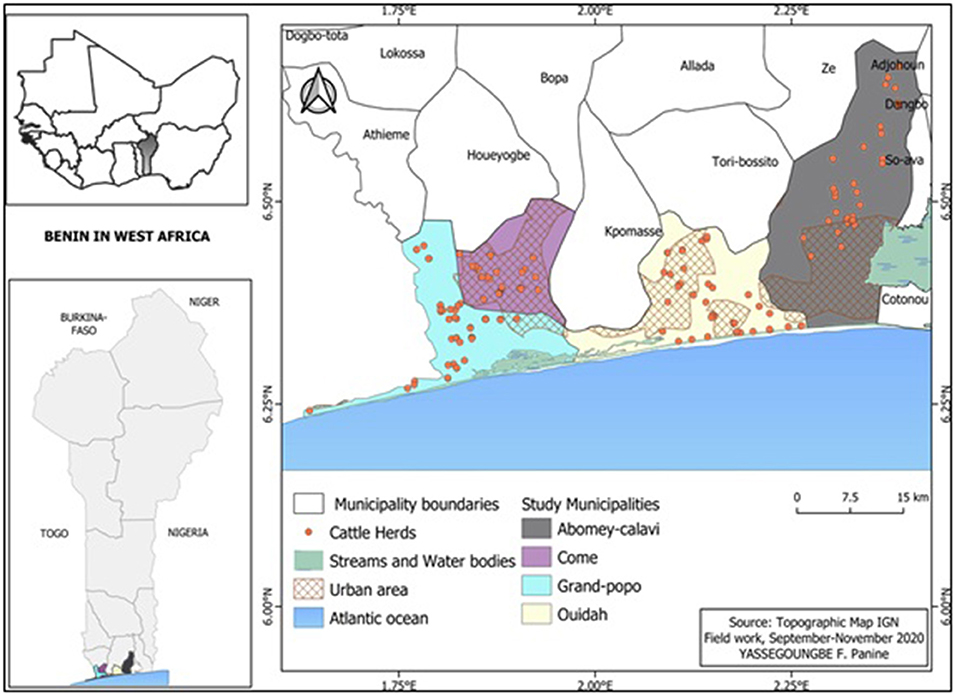
Figure 1. Map of West Africa with Benin marked in gray (upper left), Benin country (lower left) and the coastal region of Benin (right) showing the four studied municipalities and surveyed cattle herds.
Sampling of farms and data collection
A total of 190 valid records from dairy cattle keepers were obtained across the study area (Table 2). The sample was selected using the snowball sampling approach (Noy, 2008). This method was chosen because there was no pre-established list of cattle keepers available for the four municipalities, and it was difficult to contact them without going through their peers. The sampling of herds was facilitated through the collaboration with livestock officers from the Territorial Agricultural Development Agency “Agence Territoriale pour le Développement Agricole (ATDA),” and the support of the leader of the Fulani herdsmen's community in each location, who helped identify the dairy cattle keepers. Only nominated cattle farmers who accepted to participate in the survey (oral consent) were interviewed. Information of farmers not producing milk or not completing the interview, respectively, was discarded.
Data were collected at the farm level from the (male) household head through face-to-face interviews using a semi-structured paper-based questionnaire (Horton et al., 2004). The qualitative and quantitative information collected included household characteristics (ethnic group, age and gender structure, education levels, main activities, and livestock keepers' status), main sources of household income, livestock keeping experience, and training received, herd size and structure (cows' and bulls' numbers and breeds), livestock-related workforce and task distribution (herding to the pasture, milking, milk transformation, health care), milk production, transformation, and dairy product marketing, use of inputs in dairy farming, cattle health care and housing, land ownership, and land use (Appendix Table). Before its administration, the questionnaire was pre-tested on 10 cattle farms in the municipality of Abomey-Calavi that were not included in the survey, and questions were revised if necessary. In each location, the questionnaire was administrated in the local language by two experienced enumerators recruited and trained for this task.
Data analysis
Prior to statistical analysis, all questionnaires were screened for completeness and consistency of responses. All statistical analyses were done with RStudio (Version 1.4.1106). First, descriptive statistical analyses were performed to select the suitable quantitative and qualitative variables to be submitted to the factor analysis of mixed data (FAMD). A first exploratory FAMD was realized to reduce the dataset into relevant and uncorrelated variables. The analysis retained those variables that showed numbers referring to loadings higher than 0.5 (Tables 3, 4) while retaining as much information as possible (Husson et al., 2010; Mugumaarhahama et al., 2021). Subsequently, a Spearman correlation test was performed to exclude correlated variables among those retained in the FAMD. This test showed that cows' number was correlated with the quantity of milk produced per herd per day in the rainy season (0.7), the quantity of milk produced per herd per day in the dry season (0.7), and the herd size (0.5). Also, the quantity of milk produced per herd per day in the rainy season (RS) was correlated with the quantity of milk produced per herd per day in the dry season (0.8), and the cows' breed was correlated with mineral supplementation (0.6). For those reasons, the variables “cows' number,” “quantity of milk produced per herd per day in the dry season (DS),” and “mineral supplementation” were excluded.
Next, a second FAMD was performed using the uncorrelated variables (cows' breed, herd size, and quantity of milk produced per herd per day in the rainy season), and yielded three dimensions. The first three dimensions accounted for 75.5% of the explained variances with Eigenvalues greater or equal to 1 (Table 3) and were retained for the hierarchical clustering on principal components (HCPC) analysis. The analysis and visualization of the collected data were performed using the FactoMineR and factoextra packages. The clusters obtained in the HCPC analysis were compared for categorical variables using the Chi-square test, and for continuous variables using the non-parametric Kruskal-Wallis test and pairwise Wilcoxon test to characterize the different clusters. Significant differences were considered at P ≤ 0.05 for all tests listed above.
Results
Socio-economic characteristics of peri-urban dairy cattle farmers
The peri-urban dairy cattle farmers in South Benin shared many similarities with regard to their socio-economic characteristics including their socio-cultural group, level of education, main occupation, and source of income. Irrespective of the surveyed municipality, the dairy cattle farmers belonged to Fulani socio-cultural group. They were men and mostly married with only 21.1% single farmers. They were illiterate in their large majority (85.3%) with only 7.4% and 5.8% of them achieving primary and secondary school, respectively. They generally practiced cattle breeding as their main occupation (99.0%) and main source of income (96.8%). They were also all sedentary and practiced only natural grazing with no feed supplementation.
Dairy cattle farms classification
The HCPC detected six clusters of peri-urban dairy farms which were characterized as follows: (1) Small Herds of Zebu [Yakana breed, also known as White Fulani; Figure 2(1)] farms (SHZ); (2) Small Herds of Taurine [Boboji, Figure 2(2)] farms (SHT); (3) Medium Herds of Zebu (Yakana) farms (MHZ); (4) Medium Herds of Taurine (Boboji) farms (MHT); (5) Large Herds of Taurine (Boboji) and Zebu (Yakana) farms (LHTZ); and (6) Medium Herds of Zebu Goudali, Figure 2(3) mixed with Taurine (Boboji) and/or zebu Yakana farms (MHTZ). Among the farm types studied, the MHT dominated with the highest proportion of 30%, while the MHTZ and SHZ types showed the lowest proportion of 10% each (Figure 3).
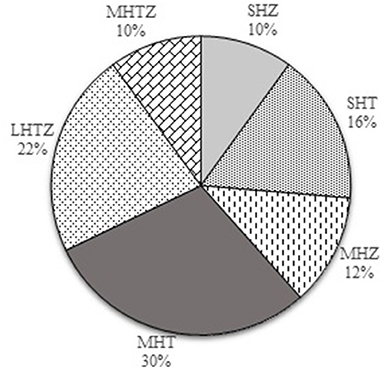
Figure 3. Proportion of different peri-urban dairy farm types in the study area in South Benin; SHZ, small herds of zebu (Yakana) farms; SHT, small herds of taurine (Boboji) farms; MHZ, medium herds of zebu (Yakana) farms; MHT, medium herds of taurine (Boboji) farms; LHTZ, large herds of taurine (Boboji) and zebu (Yakana) farms; MHTZ, medium herds of zebu Goudali mixed with taurine (Boboji) and/or zebu Yakana farms.
Although most of the dairy cattle farmers employed livestock keepers (87.9%), the 12.1% remaining, mainly found in MHZ, LHTZ and MHTZ groups, were both owners and keepers of the herd (owner-keepers). Employed keepers were all professional male herders from the Fulani ethnic group. Cattle keeping was their main occupation (99.0%) and main source of income (96.8%). Their average age was 37 ± 13.1 years with 15 ± 11.2 years of experience in cattle herding. Most of them were illiterate (85.3%), but some had primary (7.4%), secondary (5.8%), or university (1.6%) education levels. About 68.4% of them practiced cattle keeping as their sole activity. Dairy cattle keepers in LHTZ and MHZ groups were more experienced (P < 0.05) than their counterparts from the other farm types, and those in the SHT group were the least experienced. The herd sizes significantly (P < 0.001) differed between farm types. The smallest herd sizes (≤30 heads) were found in SHZ and SHT, medium herd sizes (between 31 and 70 heads) were observed in MHZ and MHT, and the largest herd sizes (≥70 heads) were found in LHTZ farm type. In consequence, LHTZ farms had the highest number of cows, whereas SHZ and SHT had the lowest (P < 0.001). The proportion of bulls in the herd was low (4.9%) in all farm types, and much more in the LHTZ group, so a wider male-to-female ratio (0.28) was observed on SHZ farms than in the other groups (P < 0.001). The three breeds encountered on the sampled farms were Boboji, Yakana, and Goudali. Their presence varied significantly (P < 0.001) across farm types. Although Boboji was common on SHT, MHT, and LHTZ farms, the Yakana breed dominated on SHZ and MHZ farms, and the Goudali was only found on MHTZ farms (Table 5).
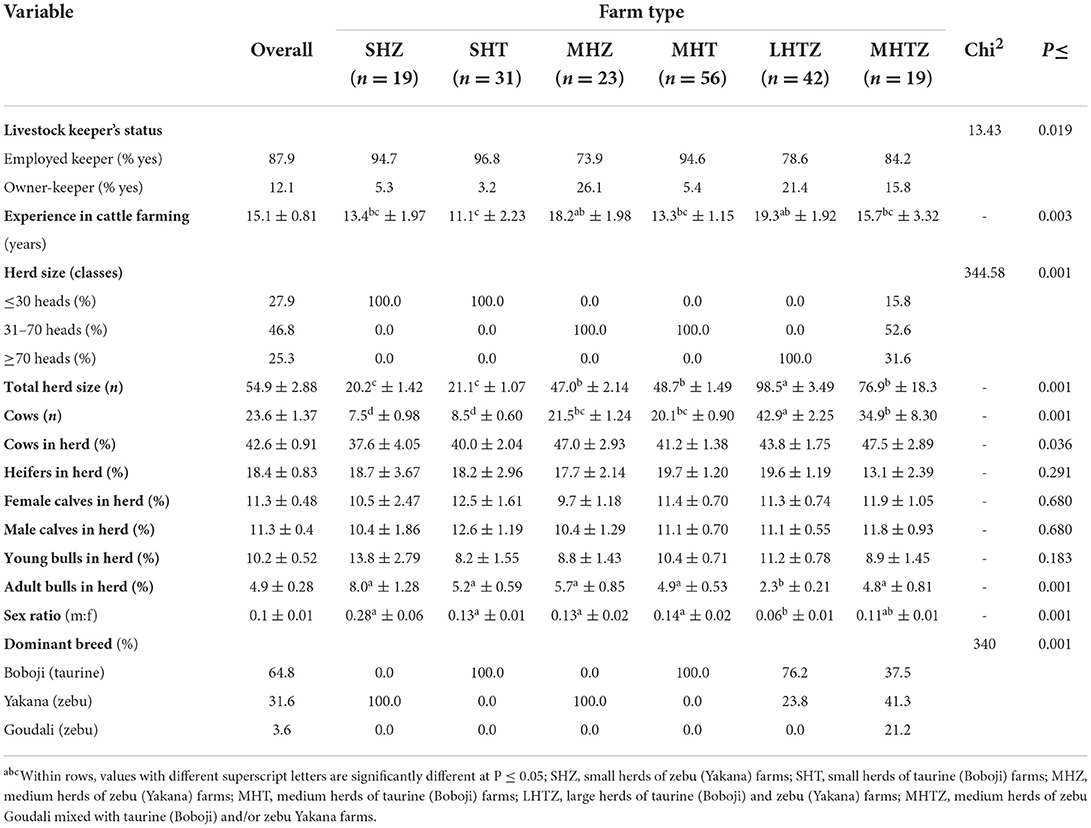
Table 5. Main characteristics of the six different dairy farm types in the peri-urban area of southern Benin; data depict either frequencies (%) or means ± standard error.
Geographical distribution of peri-urban dairy farm types
There were significant (P < 0.001) differences between the farm types in terms of their locations. Whereas SHZ (68.4%) and MHZ (47.8%) types were most common in Abomey-Calavi, the largest and most urbanized of the localities, about half of the SHT (51.6%) and MHT (50.0%) farms were found in Ouidah. Furthermore, LHTZ were mainly found in Grand-Popo (42.9%) and Comè (35.7%), while MHTZ dominated in Ouidah (47.4%) and Abomey-Calavi (31%) (Table 6).

Table 6. Geographical distribution of peri-urban dairy farm types across four study locations in South Benin.
Peri-urban dairy cattle management
Table 7 summarizes and compares the most important cattle herd management variables across the different peri-urban dairy farm types. Irrespective of farm type, all herd managers grazed their herds on communal natural pastures in their respective regions of settlement; supplementation of the animals with concentrates and transhumance were not practiced. Across farm types, the majority of livestock keepers grazed their cattle once daily; an exception was the LHTZ group, where most livestock keepers (69%) grazed their cattle twice daily (Figure 4). The daily grazing duration was higher (P < 0.05) in LHTZ farms and much lower in SHZ and SHT farms. Mineral supplementation was more commonly (P < 0.001) practiced in SHZ and MHTZ (73.7%) farm types than in the rest of the farm types, with the lowest share of only 25% of farmers in the MHT group.
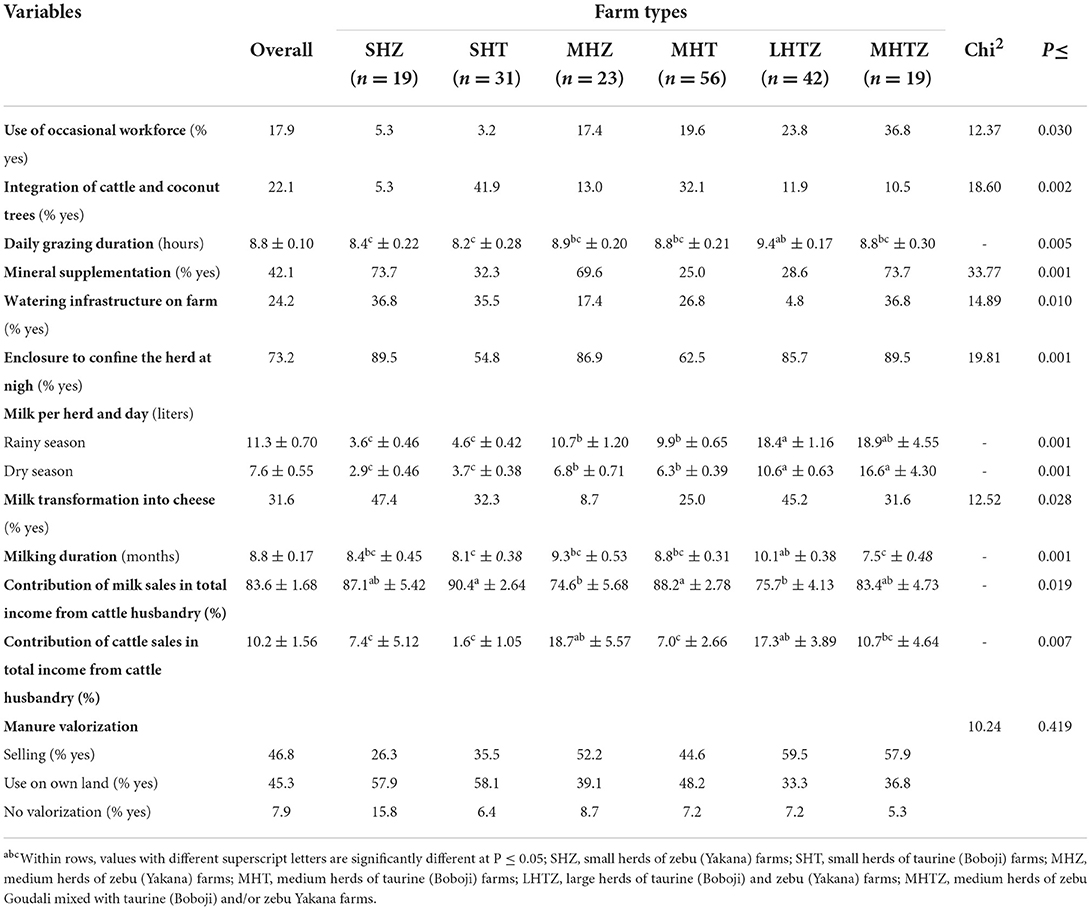
Table 7. Cattle herd management across farm types in peri-urban areas of south Benin; data depict either frequencies (%) or means ± standard error.
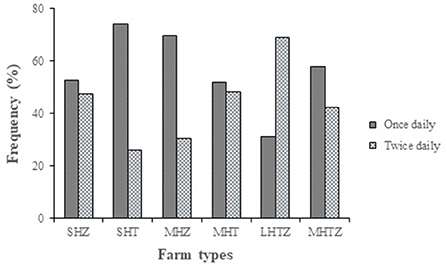
Figure 4. Grazing frequency per day across dairy cattle farm types in peri-urban areas of south Benin.
From the rainy season to the dry season, the proportion of herders who watered their cattle at the farm increased from 47.4 to 52.6% in the SHZ group, 25.8 to 61.3% in the SHT group, 17.4 to 26.1% in the MHZ group, 14.3 to 25% in the MHT group and 42.1 to 52.6% in the MHTZ group. Very few (11.9%) herders in the LHTZ group watered their cattle at the farm, irrespective of the season (Figure 5).
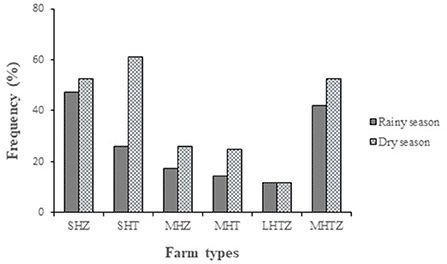
Figure 5. Cattle watering on the farm across dairy cattle farm types in peri-urban areas of south Benin.
The use of occasional workforce differed significantly (P < 0.05) among farm types and was least frequent in SHT and SHZ farms. The highest (36.8%) and lowest (3.2%) share of farms employing occasional labor were observed in MHTZ and SHT farms, respectively.
During the rainy season, LHTZ and MHTZ produced significantly (P < 0.001) higher milk volumes than other farm types, when the lowest milk production was observed in SHZ and SHT farms. The highest volume of milk during the dry season was recorded in MHTZ farms and the lowest in SHZ farms. The average milking duration was 8.8 months and significantly (P < 0.001) longer in LHZT than in the other farm types.
The quantity of milk produced per cow present in the herd varied significantly (P < 0.001) between farm types in the dry season, but not in the rainy season. The highest amount of milk produced per cow in both rainy and dry seasons (0.65 and 0.52 L/day, respectively) was recorded in the SHZ group and the lowest (0.47 and 0.26 L/day, respectively) in the LHTZ group. The amount of milk (0.52 L/day) per cow present in MHTZ farms during the dry season was similar to that recorded in SHZ farms (Figure 6).
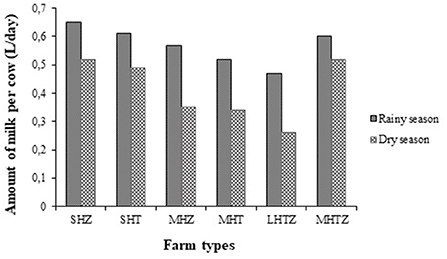
Figure 6. Daily amount of milk collected per cow present in the herd across dairy cattle farm types in peri-urban areas of south Benin.
Raw milk transformation into cheese was less commonly practiced (P < 0.05) by MHZ farms (8.7%) than by other farm types. Irrespective of farm type, parts of the produced milk and cheese were consumed by the cattle keeper's household, and the rest was sold. The lowest (P < 0.05) contribution of milk sales and the highest contribution of cattle sales to farm income were recorded in MHZ and LHTZ farms, respectively.
SHT (41.9%) and MHT (32.1%) farms, mainly located in the municipality of Ouidah, integrated cattle production with coconut tree plantations. The use of cattle manure as organic fertilizer was more frequently reported in these two farm groups, but also in SHZ farms, whereas most farms in the MHZ (52.2%), LHTZ (59.5%), and MHTZ (57.9%) groups used to sell their manure (Table 7).
Constraints of peri-urban dairy farming
The constraints faced by livestock keepers in the study area did not vary across farm types but were significantly (P < 0.001) different between municipalities (Figure 7).
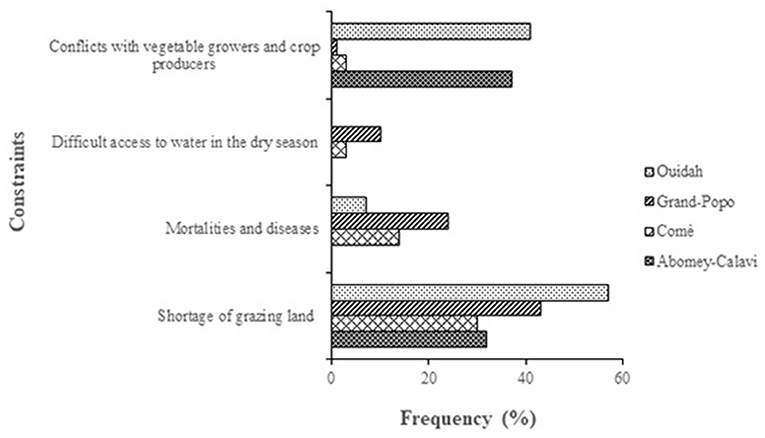
Figure 7. Main constraints (on vertical axis) of dairy cattle farming across four peri-urban locations in south Benin.
Shortage of grazing land was the most common and important constraint to dairy cattle farming systems in the peri-urban areas of south Benin, and this was attributed to urbanization and crop production, while the difficult access to water in the dry season posed a problem to a few respondents only. Shortage of grazing land was reported as a constraint, with a frequency ranging from 30 to 57% depending on the municipality. A rising number of conflicts with vegetable growers and crop producers, reported by 41% and 37% of the interviewed livestock keepers in Ouidah and Abomey-Calavi, respectively, was another important constraint. Although most livestock keepers (89.5%) vaccinated their animals and cared for the sick ones to prevent the spread of diseases and mortality, animal diseases and mortality were reported as crucial problems in Grand-Popo.
Discussion
This work aimed to characterize peri-urban dairy cattle farms in the coastal area of south Benin, in order to understand how they operate and adapt to the ongoing urbanization with its challenges and also market opportunities. However, the study was of exploratory nature only, with one of its shortcomings being the use of the snowball method to select respondents, as this method does not guarantee representativeness of the sample. Due to the support provided by the departmental representations of ruminant breeders and Fulani chiefs, this method did nevertheless allow us to visit all dairy cattle keepers in the four municipalities, even if not all of them agreed to participate in our study. Another shortcoming might be the use of a questionnaire-based survey that relies on herders' memory. This approach does not allow to collect reliable quantitative data, in particular data on the amount of milk produced in different seasons, and the quantities of inputs used. However, the method could be easily replicated in peri-urban areas of other West African coastal cities, and information collected was satisfactory for the purposes of establishing a farm typology for further in-depth studies.
As far as differences between dairy farms are concerned, cattle breeds, herd size, and quantity of milk produced per herd and day were the main distinguishing characteristics of the six farm types obtained. The criteria that distinguished the six farm types are partly different from the criteria found by Houessou et al. (2019) in rural zones of Benin, who identified practice or not of transhumance, season and distance of herd movements, herd size, and dominant breeds as main differentiating factors, whereby the latter two variables were also relevant in the present study. In contrast, the distinguishing variables are similar to those reported by Alkoiret et al. (2011) for northern Benin, and breed, in particular, seems to be an important determinant for cattle system characterization across the country. In the study area, the Zebu Goudali breed is infrequently found on dairy farms, although it is generally kept by Fulani herders (Assani and Alkoiret, 2014) and is considered a good milk producer. In the dominant MHT farm type, the Goudali was not present; rather, the dwarf-sized taurine Boboji cattle dominated the herds on these farms. The Boboji is a small-bodied breed adapted to the humid conditions of south Benin, whereas the Goudali, a shorthorn zebu cattle, is a native breed of northern Nigeria and Cameroon. Its recent introduction in Benin through transhumant herders (Houessou et al., 2022) could explain the low presence of Goudali in peri-urban dairy farms of south Benin. Its low adaptation to the main environmental constraint (i.e., trypanosomiasis disease) could also be a further important reason. A similar observation was made by Tamou et al. (2018) in the pastoral areas of northern Benin, who reported that although perceived as of high value for milk production, this breed was the least preferred by pastoralists because of its low endurance.
All interviewed livestock keepers were Fulani, and the majority was illiterate; in consequence, the livestock keeper's ethnic identity was unimportant in distinguishing farm types, which contrasts with results obtained by Dossa and Vanvanhossou (2016), Zoma-Traoré et al. (2020), and Soro et al. (2015), who reported that ethnicity explained different types of livestock keepers. For instance, Houessou et al. (2019) reported that ethnicity plays a significant role in the adoption of a specific herd mobility strategy, which was not substantiated in our study. As opposed to peri-urban cattle production in Bobo Dioulasso, Burkina Faso (Dossa et al., 2015), peri-urban dairy cattle farms around Cotonou do not practice transhumance. Daily grazing duration in all six dairy farming systems averaged 8 to 9 h and depended on travel distance. Taking cattle to grazing was important, as grazing was the only source of energy and protein in these farming systems. The herds were taken to pasture once or twice daily, depending on the pasture location, as well as on the herdsman. As in the urban area of Bengaluru in India and Bobo Dioulasso in Burkina Faso, dairy keepers in the peri-urban area of southern Benin also heavily depend on public land as pasture to feed their animals (Dossa et al., 2015; Reichenbach et al., 2021). This is explained not only by the difficult access to land, but also by the strong competition for land use, especially in the urbanized areas where buildings, crop production, and livestock must cohabit. In contrast to other peri-urban milk production systems (Dossa et al., 2015; Toure et al., 2015), dairy farmers in southern Benin neither purchased fodder and/or concentrate feeds, nor did they produce fodder on the farm. This suggests that cows and heifers are not properly fed and managed to express their genetic potential and might partly explain the low milk yields recorded on the investigated farms. However, all surveyed livestock farmers, except those located next to the sea in Grand Popo and Ouidah municipalities, offered mineral supplementation to their animals. Farmers located near the sea argued that the seawater already contains salt, so animals benefit from salt spray onto adjacent pasture land.
Livestock keepers reared cattle for both milk and meat production, but, irrespective of farm type, income generated through animal sales was low compared to that from milk sales. Indeed, employed keepers just managed the herds and did not take decisions regarding the sale of animals, while for the owners of these herds, who often belong to wealthy urban elites (Robineau and Dugué, 2018), the cattle herd might rather serve as a means of capital accumulation or to convert income from dubious sources into legal assets (Ajala, 2020). Employed keepers were paid a fixed monthly salary, whereby those in the most urbanized municipalities, namely Abomey-Calavi and Ouidah, were better paid than others. In herds where livestock keepers had full or partial control over the milk produced, as well as in owner-managed herds, the sale of milk did significantly contribute to income from cattle husbandry, which agrees with findings from Bobo Dioulasso in Burkina Faso (Dossa et al., 2015). The results also support the insights of Mugumaarhahama et al. (2021) from South-Kivu province in the eastern Democratic Republic of Congo, who reported that if there are more cows than other animal categories in the herd, milk production becomes the main objective of cattle farming, even if both milk and meat are produced. In contrast to observations by Assogba and Alkoiret (2015) in the Oueme valley in southern Benin, who stated that cattle producers specialize in either milk or meat, dairy farming systems in peri-urban areas of southern Benin supply both products. It can also be noted that the third product, manure, does not contribute significantly to household income, as it is sold at a very low price and sometimes offered to gardeners and crop farmers.
Milking was practiced once a day only, in the morning, and lasted for 7 to 10 months per lactating cow across farming systems. In view of the low milk production per animal, cattle breed was a factor that influenced the production, with higher milk yield in herds comprising a substantial number of zebu cows. This is in agreement with the result from the peri-urban zone of Bamako, Mali (Toure et al., 2015). LHTZ and MHZ farms produced the highest amount of milk per herd, due to their large herd sizes; at the same time, the average daily milk production per cow in the herd was lowest on LHTZ farms (0.26 L/cow), and therefore probably also the least profitable. In contrast, SHZ, SHT, and MHTZ farms gained more milk per cow and day than the other groups. Nevertheless, overall milk production in all systems was low compared to other studies (Toure et al., 2015; Anihouvi et al., 2019), whereby the low milk yield may be partly explained by the fact that cows were milked once a day only, which is consistent with findings reported by Ndambi et al. (2008) in Cameroon.
In some farm types, milk transformation into cheese was practiced quite frequently, although overall, it was practiced by less than 50% of the peri-urban dairy farmers. The low share of milk processing may be due to the fact that the herds were often kept and milked far from the processing unit located at the livestock keeper's home. The fact that some livestock keepers were single was another reason for not processing the milk into cheese. Indeed, being a female Fulani activity, milk transformation into traditional cheese was mainly handled by female members of a livestock keeper's household. Similar patterns were observed in other studies, where the milk collected by the livestock keepers was either processed into cheese or sold in local markets by female family members, and the livestock keeper's family consumed just a small part (Assani and Alkoiret, 2014; Daburon et al., 2014; Sessou et al., 2016). If milk transformation was not undertaken, the raw milk was directly sold at the farm gate to mobile milk collectors. Most livestock keepers (82%) perceived the sale of raw milk to be more or equally beneficial compared to the sale of milk processed into Wagashi cheese because they did not really calculate the benefit gained from each product and underestimated the value added to milk through its processing into cheese. According to our own calculations, Wagashi cheese selling increased the gain per liter of milk by 22% over selling raw milk. In view of the low price of fresh milk compared to that of Wagashi cheese, cheese production allows livestock keepers to benefit more from their livestock activity and to sustain it (Licitra, 2010).
In this study, only 7% of the surveyed livestock keepers did not valorize manure, a result that agrees with findings of previous research in other West African cities (Amadou et al., 2012; Dossa et al., 2015), but sharply contrasts with current practices elsewhere in Africa (Tadesse et al., 2021). This result reveals that cattle keepers in the coastal area of Benin are aware of the agricultural value of this resource. The high proportion of livestock keepers who reported the sale of dung to urban gardeners, irrespective of farm type, could be explained by the fact that less than 25% of them integrated crop and livestock production, as opposed to most cattle keepers (75%) in peri-urban areas of Ouagadougou, Burkina Faso, who combined both activities (Roessler et al., 2016). As highlighted by Awasthi et al. (2022), when manure is returned to cropland, it contributes to nutrient recycling as it enables to replace about 60 to 75% of chemical fertilizer. Proper management of manure in the peri-urban livestock production systems of southern Benin can be considered an important contribution to the urban circular economy (Tadesse et al., 2021; Oosting et al., 2022).
Most of the livestock keepers (52%) in farm types SHZ, SHT, and MHTZ were watering their cattle on the farm, in particular during the dry season. Watering is an important factor in milk production. It was noted that watering cattle on the farm had a positive influence on milk production because those farm types with good milk production were those watering their cattle on the farm. More frequently than others, MHTZ farms used occasional workforce in addition to family labor provided by the livestock keeper and household members. This can be explained by the important number of animals in the herd, especially cows, which need close monitoring on the pasture. Furthermore, most MHTZ farms raise the zebu Goudali cattle and provide mineral supplementation to the animals. Irrespective of production systems, Goudali cows yield more milk than Zebu Yakana and other local taurine cows (Kassa et al., 2016). Therefore, the adoption of Goudali cattle and the practice of mineral supplementation could both potentially contribute to increasing and sustaining herd milk yield. Nevertheless, high-yielding dairy cows should also be supplemented with concentrate feeds, crop residues, or silage to enable them express their full genetic potential, as has been described for the peri-urban areas of Bobo Dioulasso and Ouagadougou, Burkina Faso (Dossa et al., 2015; Roessler et al., 2016).
Besides cow breed and feeding, herd structure is another important factor that significantly impacts the herd's milk productivity and profitability (Liang and Cabrera, 2015). The higher the proportion of mature and productive cows in a herd, the higher the milk production and feed use efficiency (Connor et al., 2013). In the current study, the herd structure was similar across the different farm types, with average proportions of cows (dry and lactating) and heifers ranging from 37.6 to 47.5% and from 13.1 to 19.7%, respectively. Marshall et al. (2020) reported a similar herd structure in smallholder dairy farms in Senegal. But despite their small size, SHZ and SHT farm types produced more milk per cow than other farm types. These farm types might keep a higher proportion of mature lactating cows, thus productive cows, and fewer first-lactating and/or dry cows; as has been shown by Liang and Cabrera (2015), a higher share of first-lactating and or/dry cows in a herd reduces the average milk yield per cow. In addition to improved feeding strategies, increasing herd-level milk yield in peri-urban areas of southern Benin will therefore also require a balanced ratio between productive and non-productive animals.
As increasing milk yield per cow in small farms is a promising strategy for environmentally-friendly dairy production in Africa (De Vries et al., 2019), and effective in reducing food insecurity (Ong and Liao, 2020), we argue that SHZ and SHT farm types should be targeted for sustainable intensification of peri-urban dairy production in southern Benin, especially since the management of small herds did not require additional hiring of occasional labor.
Conclusion
In the peri-urban area of southern Benin, dairy cattle farms are mainly managed by members of the Fulani ethnic group who are mostly employed livestock keepers. Milk, either sold raw or processed into traditional cheese by female household members, represents the main source of farm income. The proximity of these farms to the country's biggest cities in the coastal area is beneficial for consumers of milk and milk products, and for the livestock keepers' revenues, but not for dairy cattle management. With the ongoing rapid urbanization and population growth, finding adequate feed and water resources for the dairy herds is increasingly challenging due to the drastic reduction of grazing lands, escalating conflicts with crop producers, and with the residential population. To cope with these constraints, livestock keepers spend more time searching for pasture to feed their cattle. The amount of milk produced under those conditions is small, especially when considering the substantial number of cows in the herd. To address these drawbacks, livestock keepers can improve their feeding strategies by using more crop residues directly in the field after harvesting or by purchasing feed at the local livestock marketplace. As selling milk in urban areas can yield substantial profit, livestock keepers should be willing to invest in livestock management to improve milk production, reproduction, and also the growth of their animals. Among the six identified peri-urban dairy farm types, the small-scale farms with a mixed herd of zebu and taurine cattle produce the highest amounts of milk per cow and could therefore be the first ones to be targeted by researchers and policy-makers for sustainable intensification of peri-urban dairy production in southern Benin.
Data availability statement
The original contributions presented in the study are included in the article/Supplementary material, further inquiries can be directed to the corresponding author.
Author contributions
FY, ES, and LD designed the study. FY and DO collected the data. FY performed statistical analyses and drafted the manuscript. AA, ES, and LD reviewed and edited the manuscript. All authors contributed to the article and approved the submitted version.
Funding
This study was financially supported by the VolkswagenStiftung, Hannover, Germany through the Postdoctoral research grant Az 94 829. FY received a personal stipend from German Academic Exchange Service (DAAD): Research Grants – Bi-nationally Supervised Doctoral Degrees/Cotutelle.
Acknowledgments
The authors are very grateful to all participating farmers for their valuable help and cooperation during the fieldwork. Sincere thanks go to two reviewers for their insightful and constructive comments and to Mrs. Sandrine O. Houessou for her support during the writing process.
Conflict of interest
The authors declare that the research was conducted in the absence of any commercial or financial relationships that could be construed as a potential conflict of interest.
Publisher's note
All claims expressed in this article are solely those of the authors and do not necessarily represent those of their affiliated organizations, or those of the publisher, the editors and the reviewers. Any product that may be evaluated in this article, or claim that may be made by its manufacturer, is not guaranteed or endorsed by the publisher.
Supplementary material
The Supplementary Material for this article can be found online at: https://www.frontiersin.org/articles/10.3389/fsufs.2022.1001497/full#supplementary-material
Footnotes
1. ^15 244 790 Euros.
References
Aboh, A. B. (2001). Importance, contraintes et voies de développement des élevages urbains et périurbains dans la région Sud du Bénin. Rapport de recherche. Cotonou: ICRA/GTZ/INRAB, 30.
Ahmed, S., Dávila, J. D., Allen, A., Haklay, M., Tacoli, C., and Fèvre, E. M. (2019). Does urbanization make emergence of zoonosis more likely? Evidence, myths and gaps. Environ. Urban. 31, 443–460. doi: 10.1177/0956247819866124
Ajala, O. (2020). New drivers of conflict in Nigeria: an analysis of the clashes between farmers and pastoralists. Third World Q. 41, 2048–2066. doi: 10.1080/01436597.2020.1811662
Alkoiret, T. I., Radji, M., and Babatoundé, S. (2011). Typologie des élevages bovins installés dans la commune de Ouaké au nord-ouest du Bénin. Livest. Res. Rural Dev. 23, 1–12. doi: 10.4314/asab.v12i2.53854
Amadou, H., Dossa, L. H., Lompo, D. J.-P., Abdulkadir, A., and Schlecht, E. (2012). A comparison between urban livestock production strategies in Burkina Faso, Mali and Nigeria in West Africa. Trop. Anim. Health Prod. 44, 1631–1642. doi: 10.1007/s11250-012-0118-0
Anihouvi, E. L., Salih, H., Anihouvi, V. B., and Kesenkas, H. (2019). Milk and dairy products production in benin. Akademik Gida 17, 508–516. doi: 10.24323/akademik-gida.667265
Assani, S. A. and Alkoiret, T. I. (2014). Typology of Gudali cattle farms located in the commons of malancity and karimama extreme North of Benin. Int. J. Adv. Sci. 4, 1–5.
Assogba, B. G. C. and Alkoiret, T. I. (2015). Typology of Lagune cattle farms located in the Oueme valley in Southern Benin. Int. J. Adv. Sci. 5, 1–6.
Awasthi, S. K., Kumar, M., Sarsaiya, S., Ahluwalia, V., Chen, H., Kaur, G., et al. (2022). Multi-criteria research lines on livestock manure biorefinery development towards a circular economy: From the perspective of a life cycle assessment and business models strategies. J. Clean. Prod. 341, 130862. doi: 10.1016/j.jclepro.2022.130862
Ayantunde, A. A., Duncan, A. J., van Wijk, M. T., and Thorne, P. (2018). Role of herbivores in sustainable agriculture in Sub-Saharan Africa. Animal 12, 199–209. doi: 10.1017/S175173111800174X
Benis, K. and Ferrão, P. (2017). Potential mitigation of the environmental impacts of food systems through urban and peri-urban agriculture (UPA) – a life cycle assessment approach. J. Clean. Prod. 140, 784–795. doi: 10.1016/j.jclepro.2016.05.176
Boko, C., Adje, Y., Atindogbe, G., Hounmanou, Y. M., Dossa, F., Sessou, P., et al. (2016). Evaluation of the production technologies and the microbial and physico-chemical qualities of curdled milk produced in Benin. J. Appl. Biosci. 104, 10019–10033. doi: 10.4314/jab.v104i1.14
Cesaro, J-D. and Apolloni, A. (2020). Élevage et urbanité, dans les villes développées ou en développement, quelles oppositions et quelles complémentarités? Territoire en Mouvement Revue de Géographie et Aménagement 4, 44–45. doi: 10.4000/tem.6131
Chatellier, V. (2020). La dépendance de l'Afrique de l'Ouest aux importations de produits laitiers. INRAE Prod. Anim. 33, 125–140. doi: 10.20870/productions-animales.2020.33.2.4027
Connor, E. E., Hutchison, J. L., Norman, H. D., Olson, K. M., Van Tassell, C. P., Leith, J. M., et al. (2013). Use of residual feed intake in Holsteins during early lactation shows potential to improve feed efficiency through genetic selection. J. Anim. Sci. 91, 3978–3988 doi: 10.2527/jas.2012-5977
Craighead, L., Meyer, A., Chengat, B., Musallam, I., Akakpo, J., Kone, P., et al. (2018). Brucellosis in West and Central Africa: a review of the current situation in a changing landscape of dairy cattle systems. Acta Trop. 179, 96–108. doi: 10.1016/j.actatropica.2017.12.026
Daburon, A., Tourrand, J. F., Alary, V., Ali, A., and Elsorougy, M. (2014). Typologie exploratoire des systèmes d'élevage laitier familiaux de la mégalopole du Grand Caire en Egypte, contraintes et opportunités. Rev. Elev. Med. Vet. Pays Trop. 67,173–182. doi: 10.19182/remvt.20559
De Vries, M., Zahra, W. A., Wouters, A. P., van Middelaar, C. E., Oosting, S. J., Tiesnamurti, B., et al. (2019). Entry points for reduction of greenhouse gas emissions in small-scale dairy farms: looking beyond milk yield increase. Front. Sustain. Food Syst. 3, 49. doi: 10.3389/fsufs.2019.00049
Delisle, H., Ntandou-Bouzitou, G., Agueh, V., Sodjinou, R., and Fayomi, B. (2012). Urbanisation, nutrition transition and cardiometabolic risk: the Benin study. Br. J. Nutr. 107, 1534–1544. doi: 10.1017/S0007114511004661
Deteurtre, G., Corniaux, C., and Boutonnet, J.-P. (2003). Baisse de la consommation des produits laitiers en Afrique subsaharienne : mythe ou réalité? Renc. Rech. Ruminants 10, 321–326.
Direction des Statistiques Agricoles (DSA) (2022). Indicateurs macroéconomiques et statistiques annuelles 2021 sur le secteur agricole au Bénin. Available online at: https://apidsa.agriculture.gouv.bj/public/storage/uploads/DwzlMhNfiYNsPA7CkFpfoh3AU45sLoorGUeMuF7E.pdf (accessed April 21, 2022).
Dossa, L. H., Sangaré, M., Buerkert, A., and Schlecht, E. (2015). Intra-urban and peri-urban differences in cattle farming systems of Burkina Faso. Land Use Policy 48, 401–411. doi: 10.1016/j.landusepol.2015.06.031
Dossa, L. H., and Vanvanhossou, F. U. S. (2016). The indigenous Somba cattle of the hilly Atacora region in North-West Benin: threats and opportunities for its sustainable use. Trop. Anim. Health Prod. 48, 349–359. doi: 10.1007/s11250-015-0958-5
Enahoro, D., Lannerstad, M., Pfeifer, C., and Dominguez-Salas, P. (2018). Contributions of livestock-derived foods to nutrient supply under changing demand in low-and middle-income countries. Glob. Food Secur. 19, 1–10. doi: 10.1016/j.gfs.2018.08.002
FAOSTAT (2017). Crop and Livestock Products. Available online at: http://www.fao.org/faostat/en/#data/TP (accessed June 21, 2021).
Follmann, A., Willkomm, M., and Dannenberg, P. (2021). As the city grows, what do farmers do? A systematic review of urban and peri-urban agriculture under rapid urban growth across the Global South. Landsc. Urban Plan. 215, 104186. doi: 10.1016/j.landurbplan.2021.104186
Graefe, S., Buerkert, A., and Schlecht, E. (2019). Trends and gaps in scholarly literature on urban and peri-urban agriculture. Nut. Cycl. Agroecosyst. 115, 143–158. doi: 10.1007/s10705-019-10018-z
Hatab, A. A., Cavinato, M. E. R., and Lagerkvist, C. J. (2019). Urbanization, livestock systems and food security in developing countries: a systematic review of the literature. Food Secur. 11, 279–299. doi: 10.1007/s12571-019-00906-1
Holdsworth, M., and Landais, E. (2019). Urban food environments in Africa: implications for policy and research. Proc. Nutr. Soc. 78, 513–525. doi: 10.1017/S0029665118002938
Horton, J., Macve, R., and Struyven, G. (2004). “Qualitative research: experiences in using semi-structured interviews,” in The Real Life Guide to Accounting Research: A Behind-the-Scenes View of Using Qualitative Research Methods, eds C. Humphrey and B. Lee (Amsterdam: Elsevier), 339–357. doi: 10.1016/B978-008043972-3/50022-0
Houessou, S. O., Dossa, L. H., Diogo, R. V. C., Houinato, M., Buerkert, A., and Schlecht, E. (2019). Change and continuity in traditional cattle farming systems of West African Coast countries: a case study from Benin. Agric. Syst. 168, 112–122. doi: 10.1016/j.agsy.2018.11.003
Houessou, S. O., Vanvanhossou, S. F. U., Diogo, R. V. C., and Dossa, L. H. (2022). Dynamics of changes in the breed composition of pastoral and agro-pastoral cattle herds in Benin: implications for the sustainable use of indigenous breeds. Heliyon 8, e09229. doi: 10.1016/j.heliyon.2022.e09229
Husson, F., Josse, J., and Pages, J. (2010). Principal Component Methods Hierarchical Clustering-Partitional Clustering: Why Would We Need to Choose for Visualizing Data? Rennes: Agrocampus Ouest, Applied Mathematics Department.
INSAE (2015). RGPH4 : Que retenir de la population en 2013. Direction des études démographiques, INSAE, Cotonou, Bénin. Available online at : https://instad.bj/images/docs/insae-statistiques/demographiques/population/Resultats%20definitifs%20RGPH4.pdf (accessed February 21, 2022).
Kapaj, A., and Deci, E. (2017). “World milk production and socio-economic factors effecting its consumption,” in Dairy in Human Health and Disease Across the Lifespan, eds R. R. Watson, R. J. Collier, and V. R. Preedy (Cambridge, MA, USA: Academic Press), 107–115. doi: 10.1016/B978-0-12-809868-4.00007-8
Kassa, K. S., Ahounou, S., Dayo, G. K., Salifou, C., Issifou, M. T., Dotche, I., et al. (2016). Performances de production laitière des races bovines de l'Afrique de l'Ouest. Int. j. biol. chem. sci. 10, 2316–2330. doi: 10.4314/ijbcs.v10i5.29
Koura, I., Dossa, L. H., Houinato, M., and Kassa, B. (2015). Adaptation of peri-urban cattle production systems to environmental changes: feeding strategies of herdsmen in southern Benin. Agroecol. Sustain. Food Syst. 39, 83–98. doi: 10.1080/21683565.2014.953662
Latino, L. R., Pica-Ciamarra, U., and Wisser, D. (2020). Africa: the livestock revolution urbanizes. Glob. Food Secur. 26, 100399. doi: 10.1016/j.gfs.2020.100399
Liang, D., and Cabrera, V. E. (2015). Optimizing productivity, herd structure, environmental performance, and profitability of dairy cattle herds. J. Dairy Sci. 98, 2812–2823. doi: 10.3168/jds.2014-8856
Licitra, G. (2010). World wide traditional cheeses: banned for business? Dairy Sci. Technol. 90, 357–374. doi: 10.1051/dst/2010016
Marshall, K., Salmon, G. R., Tebug, S., Juga, J., MacLeod, M., Poole, J., et al. (2020). Net benefits of smallholder dairy cattle farms in Senegal can be significantly increased through the use of better dairy cattle breeds and improved management practices. J. Dairy Sci. 103, 8197–8217. doi: 10.3168/jds.2019-17334
Molina-Flores, B., Manzano-Baena, P., and Coulibaly, M. D. (2020). The Role of Livestock in Food Security, Poverty Reduction and Wealth Creation in West Africa. FAO.
Mugumaarhahama, Y., Ayagirwe, R. B. B., Mutwedu, V. B., Cirezi, N. C., Wasso, D. S., Azine, P. C., et al. (2021). Characterization of smallholder cattle production systems in South-Kivu province, eastern Democratic Republic of Congo. Pastoralism: Research, Policy and Practice 11, 1–15. doi: 10.1186/s13570-020-00187-w
Nakasaki, K., Yanagisawa, M., and Kobayashi, K. (2008). Microbiological quality of fermented milk produced by repeated-batch culture. J. Biosci. Bioeng. 105, 73–76. doi: 10.1263/jbb.105.73
Ndambi, O. A., Tchouamo, I., Bayemi, P. H., and Hemme, T. (2008). Milk production amongst Fulani Grazers in the Western Highlands of Cameroon: constraints and development perspectives. livest. Res. Rural Dev. 20, 13. Available online at: http://www.lrrd.org/lrrd20/1/ndam20013.htm (accessed July 5, 2022).
Noy, C. (2008). Sampling knowledge: the hermeneutics of snowball sampling in qualitative research. Int. J. Soc. Res. Methodol. 11, 327–344. doi: 10.1080/13645570701401305
Ong, T. W. Y., and Liao, W. (2020). Agroecological transitions: a mathematical perspective on a transdisciplinary problem. Front. Sustain. Food Syst. 4, 91. doi: 10.3389/fsufs.2020.00091
Oosting, S., van der Lee, J., Verdegem, M., de Vries, M., Vernooij, A., Bonilla-Cedrez, C., et al. (2022). Farmed animal production in tropical circular food systems. Food Sec. 14, 273–292. doi: 10.1007/s12571-021-01205-4
Pongrácz, E., and Pohjola, V. J. (2004). Re-defining waste, the concept of ownership and the role of waste management. Resour. Conserv. Recycl. 40, 141–153. doi: 10.1016/S0921-3449(03)00057-0
Poulsen, M. N., McNab, P. R., Clayton, M. L., and Neff, R. A. (2015). A systematic review of urban agriculture and food security impacts in low-income countries. Food Policy 55, 131–146. doi: 10.1016/j.foodpol.2015.07.002
Reichenbach, M., Pinto, A., König, S., Bhatta, R., and Schlecht, E. (2021). Dairy production in an urbanizing environment—typology and linkages in the megacity of Bengaluru, India. PLoS ONE 16, e0255791. doi: 10.1371/journal.pone.0255791
Robineau, O., and Dugué, P. (2018). A socio-geographical approach to the diversity of urban agriculture in a West African city. Landsc. Urban Plan. 170, 48–58. doi: 10.1016/j.landurbplan.2017.09.010
Roessler, R., Mpouam, S. E., Muchemwa, T., and Schlecht, E. (2016). Emerging development pathways of urban livestock production in rapidly growing West Africa cities. Sustainability 8, 1199. doi: 10.3390/su8111199
Sessou, P., Boko, C., Hounmanou, G., Osseni, S. D., Hounkpe, E., Azokpota, P., et al. (2016). Preservation of traditional cheese wagashi using essential oils: impact on microbiological, physico-chemical and sensorial characteristics. Br. Microbiol. Res. J. 15, 1–13. doi: 10.9734/BMRJ/2016/27536
Sessou, P., Farougou, S., Azokpota, P., Youssao, I., Yèhouenou, B., Ahounou, S., et al. (2013). Endogenous methods for preservation of Wagashi, a Beninese traditional cheese. AJAR 8, 4254–4261. doi: 10.5897/AJAR2013.6908
Soro, B., Sokouri, D. P., Dayo, G. K., N'Guetta, A. S. P., and Yapi Gnaoré, C. V. (2015). Caractérisation des bovins de race Baoulé dans le “Pays Lobi” de Côte d'Ivoire: rôles socioéconomiques, modes d'élevage et contraintes de production. Tropicultura 33, 111–124.
Sounon, A. (2016). Diversité, vulnérabilité et adaptation de l'élevage bovin dans le bassin de la Donga au Bénin : changement du milieu et transformation des systèmes. Thèse Doct., Université d'Abomey-Calavi, Abomey-Calavi, Bénin, 257.
Swain, B. B. and Teufel, N. (2017). The impact of urbanisation on crop–livestock farming system: a comparative case study of India and Bangladesh. J. Econ. Soc. Dev. 19, 161–180. doi: 10.1007/s40847-017-0038-y
Tadesse, S. T., Oenema, O., van Beek, C., and Ocho, F. L. (2021). Manure recycling from urban livestock farms for closing the urban-rural nutrient loops. Nutr. Cycl. Agroecosyst. 119, 51–67. doi: 10.1007/s10705-020-10103-8
Tamou, C., de Boer, I. J., Ripoll-Bosch, R., and Oosting, S. J. (2018). Understanding roles and functions of cattle breeds for pastoralists in Benin. Livest. Sci. 210, 129–136. doi: 10.1016/j.livsci.2018.02.013
Tèka, O. (2010). Méthode d'analyse de processus spatiaux dans les pays en développement : L'exemple de la zone côtière du Bénin. Thèse de Doctorat, Université de Karlsruhe, 312.
Teka, O., Sturm-Hentschel, U., Vogt, J., Bähr, H. P., Hinz, S., and Sinsin, B. (2012). Process analysis in the coastal zone of Benin through remote sensing and socio-economic surveys. Ocean Coast. Manag. 67, 87–100. doi: 10.1016/j.ocecoaman.2012.06.005
Thapa, P., Torralba, M., Buerkert, A., Dittrich, C., and Plieninger, T. (2021). Ecological and social outcomes of urbanization on regional farming systems: a global synthesis. Ecol. Soc. 26, 24. doi: 10.5751/ES-12579-260324
Tiando, D. S., Hu, S., Fan, X., and Ali, M. R. (2021). Tropical coastal land-use and land cover changes impact on ecosystem service value during rapid urbanization of Benin, West Africa. Int. J. Environ. Res. Public Health. 18, 7416. doi: 10.3390/ijerph18147416
Toure, A., Moula, N., Kouriba, A., Traore, B., Tindano, K., Leroy, P., et al. (2015). Dairy farms typology and management of animal genetic resources in the peri-urban zone of Bamako (Mali). J. Agric. Rural Dev. Trop. Subtrop. 116, 37–47.
Uyttendaele, M., Jaykus, L. A., Amoah, P., Chiodini, A., Cunliffe, D., Jacxsens, L., et al. (2015). Microbial hazards in irrigation water: standards, norms, and testing to manage use of water in fresh produce primary production. Compr. Rev. Food Sci. Food Saf. 14, 336–356. doi: 10.1111/1541-4337.12133
Vall, E., Sib, O., Vidal, A., and Delma, J. B. (2021). Dairy farming systems driven by the market and low-cost intensification in West Africa: the case of Burkina Faso. Trop. Anim. Health Prod. 53, 1–7. doi: 10.1007/s11250-021-02725-z
Wang, Y., Li, X., Li, J., Huang, Z., and Xiao, R. (2018). Impact of rapid urbanization on vulnerability of land system from complex networks view: a methodological approach. Complexity 2018, 1–18. doi: 10.1155/2018/8561675
World Population Review (2022). Benin Population 2022 (Demographics, Maps, Graphs). Available online at: https://worldpopulationreview.com/countries/benin-population (accessed March, 2022).
Keywords: dairy production systems, herd size, smallholder livestock keepers, urbanization, West Africa
Citation: Yassegoungbe FP, Oloukoi D, Aoudji AKN, Schlecht E and Dossa LH (2022) Insights into the diversity of cow milk production systems on the fringes of coastal cities in West Africa: A case study from Benin. Front. Sustain. Food Syst. 6:1001497. doi: 10.3389/fsufs.2022.1001497
Received: 23 July 2022; Accepted: 26 August 2022;
Published: 13 September 2022.
Edited by:
Adeyemi Oludapo Olusola, York University, CanadaReviewed by:
Rodrigue V. Cao Diogo, University of Benin, NigeriaBabette Abanda, University of Tübingen, Germany
Copyright © 2022 Yassegoungbe, Oloukoi, Aoudji, Schlecht and Dossa. This is an open-access article distributed under the terms of the Creative Commons Attribution License (CC BY). The use, distribution or reproduction in other forums is permitted, provided the original author(s) and the copyright owner(s) are credited and that the original publication in this journal is cited, in accordance with accepted academic practice. No use, distribution or reproduction is permitted which does not comply with these terms.
*Correspondence: Luc Hippolyte Dossa, aGlwcG9seXRlLmRvc3NhQGZzYS51YWMuYmo=
 Fifame Panine Yassegoungbe
Fifame Panine Yassegoungbe David Oloukoi1
David Oloukoi1 Augustin K. N. Aoudji
Augustin K. N. Aoudji Eva Schlecht
Eva Schlecht Luc Hippolyte Dossa
Luc Hippolyte Dossa